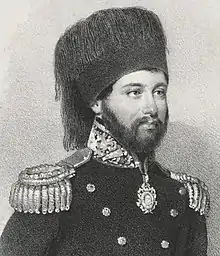Gürcü · Damat Halil Rifat | |
|---|---|
 | |
| Grand Admiral of the Ottoman Empire | |
| In office 1830–1832 | |
| Monarch | Mahmud II |
| Preceded by | Pabuççu Ahmed Pasha |
| Succeeded by | Çengeloğlu Tahir Mehmet Pasha |
| In office 1843–1845 | |
| Preceded by | Çengeloğlu Tahir Mehmet Pasha |
| Succeeded by | Damat Mehmed Ali Pasha |
| In office 1847–1848 | |
| Preceded by | Damat Mehmed Ali Pasha |
| Succeeded by | Damat Mehmed Ali Pasha |
| In office 1854–1855 | |
| Monarch | Abdulmejid I |
| Preceded by | Kıbrıslı Mehmed Pasha |
| Succeeded by | Damat Mehmed Ali Pasha |
| Personal details | |
| Born | c. 1795 Georgia |
| Died | 4 March 1856 (aged 58-59) Constantinople, Ottoman Empire (present day Istanbul, Turkey |
| Nationality | Ottoman |
| Spouse(s) | Fülane Hanim Saliha Sultan Ismet Hanım |
| Children | First marriage Ali Bey Second marriage Sultanzade Abdülhamid Bey Efendi Sultanzade Cavid Bey Efendi Ayşe Şıdıka Hanımsultan Third marriage Asaf Mahmud Celaleddin Pasha |
Damat Gürcü Halil Rifat Pasha, (Ottoman Turkish: داماد کرجی خلیل رفعت پاشا; c. 1795 – 3 March 1856) was an Ottoman admiral and statesman of Georgian origin. He served in the periods of Mahmud II and Abdulmejid I.
Career
Halil Rifat Pasha was a slave, protégé and later rival of Koca Hüsrev Mehmed Pasha. He first served as the ambassador to Russia from 1829 to 1830.[1] He then served as grand admiral for four times from 1830 to 1832, 1843–1845, 1847–1848 and 1854–1855,[2] as well as chairman of the Supreme Council of Judicial Ordinances ("Meclis-i Vâlâ") from 1842 to 1845 and 1849–1850. He also served as serasker from 1836 to 1838 and 1839–1840. This placed him in a good position to build and maintain a conservative group, usually in corporation with Hüsrev Pasha.[3]
Family
Halil Rifat had three wives:
- (Fülane) Hanim. Unknown name wife by who he divorced to marry Saliha Sultan. From her he had at least one son:
- Ali Paşah, ambassador to Austria. He in turn had a son:
- Ali Füad Ürfi Bey. He married Ayşe Sidika Hanımsultan, daughter of Cemile Sultan, daughter of the sultan Abdülmejid I and granddaughter of sultan Mahmud II. By her he had two daughters:
- Kerime Hanım
- Naime Hanım
- Ali Füad Ürfi Bey. He married Ayşe Sidika Hanımsultan, daughter of Cemile Sultan, daughter of the sultan Abdülmejid I and granddaughter of sultan Mahmud II. By her he had two daughters:
- Ali Paşah, ambassador to Austria. He in turn had a son:
- Saliha Sultan. Daughter of the sultan Mahmud II, they married on 22 May 1834 and he widowed in February 1843. Their marriage was unhappy, but by her he had two sons and a daughter:[4][5][6][7]
- Sultanzade Abdülhamid Bey Efendi (2 March 1835 - March 1837).
- Sultanzade Cavid Bey Efendi (1837 -?).
- Ayşe Şıdıka Hanımsultan (1841 - 1886). She married Server Paşah, son of Said Server Efendi. She had at least three daughters:
- Ayşe Hanim.
- Azize Hanim. She married Hariciyeci Suad Bey and had two sons, Ziya Songülen and Mahmud Bey and a daughter Fehire Hanim.
- Fatma Hanim. She married Fehmi Bey, son of the grand vizier Mehmed Esad Saffet Pasha, and had a son, Halil Bey, and a daughter, Belkis Hanim.
After Saliha's death, he married:[8]
- Ismet Hanim. From her he had a son:
- Asaf Mahmud Celaleddin Pasha (1853 - 1903). He had three wives:
- Hacer Hanim. From her he had a son:
- Halil Rifat Bey
- Iffet Hanim. By her he had two children:
- Ali Füad Bey
- Asım Bey
- Seniha Sultan, daughter of Sultan Abdülmejid I and granddaughter of Sultan Mahmud II. They married in February 1877 and had two children by her:
- Sultanzade Mehmed Sabahaddin (13 February 1879 – 30 June 1948). He had two wives and a daughter.
- Sultanzade Ahmed Lütfullah Bey. She had two wives, Kamran Hanim and a Hungarian woman, with whom he had a son, Nadi Bey.
- Hacer Hanim. From her he had a son:
- Asaf Mahmud Celaleddin Pasha (1853 - 1903). He had three wives:
Death
Hali Rifat Pasha died in Constantinople, Ottoman Empire (present day Istanbul, Turkey) on 3 March 1856.[9]
See also
References
- ↑ Historical Abstracts: Modern history abstracts, 1450-1914, Volume 49, Issues 3-4. American Bibliographical Center, Clio. 1998. p. 757.
- ↑ Aksan, Virginia (January 14, 2014). Ottoman Wars, 1700-1870: An Empire Besieged. Routledge. p. 409. ISBN 978-1-317-88403-3.
- ↑ Shaw, Stanford J.; Shaw, Ezel Kural (May 27, 1977). History of the Ottoman Empire and Modern Turkey: Volume 2, Reform, Revolution, and Republic: The Rise of Modern Turkey 1808-1975, Volume 11. Cambridge University Press. pp. 36, 69, 487. ISBN 978-0-521-29166-8.
- ↑ Uluçay, M. Çağatay (2001). Padişahların kadınları ve kızları (in Turkish). Türk Tarih Kurumu Basımevi. p. 190. ISBN 978-975-437-840-5. OCLC 949604569. Retrieved January 19, 2022.
- ↑ Lutfı̂, Ahmet (1999). Vak'anüvı̂s Ahmed Lûtfı̂ Efendi tarihi (in Turkish) (1. baskı ed.). Türkiye Ekonomik ve Toplumsal Tarih Vakfı. p. 827. ISBN 975-08-0074-5. OCLC 44065146. Retrieved January 19, 2022.
- ↑ Aynur, Hatice; Efendi, Esat; Rıfat, Halil İbrahim (1995). Saliha Sultan'ın düğününü anlatan surnâmeler, 1834: inceleme, tenkitli metin ve tıpkıbasım (in Turkish). Harvard Üniversitesi Yakındoğu Dilleri ve Medeniyetleri Bölümü. p. 8. OCLC 34479673. Retrieved January 19, 2022.
- ↑ Haskan, Mehmet Nermi (2008). Eyüp Sultan tarihi (in Turkish). Eyüpsultan Belediyesi. p. 463. ISBN 978-975-6087-04-6. OCLC 949551647. Retrieved January 19, 2022.
- ↑ Malatyalı, Ahmet; Çalışan, İrfan (2005). Tarihi, kültürü ve sanatıyla Eyüpsultan Sempozyumu, IX: tebliğler (in Turkish). Eyüp Belediyesi Kültür ve Turizm Müdürlüğü. ISBN 975-6087-02-1. OCLC 69674263. Retrieved 19 January 2022.
- ↑ Haskan, Mehmet Nermi (2001). Yüzyıllar boyunca Üsküdar. Vol. 3. Üsküdar Belediyesi. p. 1402. ISBN 978-9-759-76063-2.